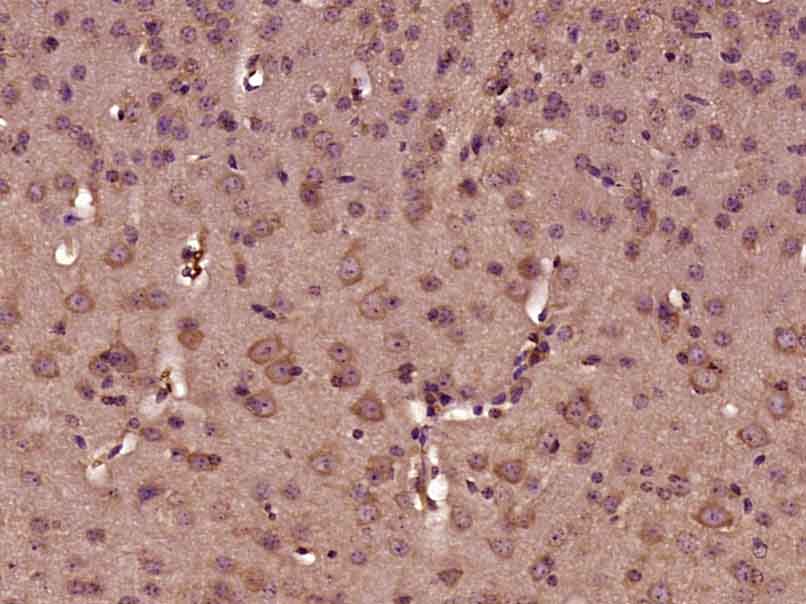ENPP6 Rabbit pAb
ENPP6 Rabbit pAb
- 产品详情
- 实验流程
- 背景知识
Application
| WB, IHC-P, IHC-F, IF |
|---|---|
| Primary Accession | Q6UWR7 |
| Reactivity | Human, Mouse, Rat |
| Predicted | Dog, Pig, Horse |
| Host | Rabbit |
| Clonality | Polyclonal |
| Calculated MW | 50241 Da |
| Physical State | Liquid |
| Immunogen | KLH conjugated synthetic peptide derived from human ENPP6 |
| Epitope Specificity | 251-350/440 |
| Isotype | IgG |
| Purity | affinity purified by Protein A |
| Buffer | 0.01M TBS (pH7.4) with 1% BSA, 0.02% Proclin300 and 50% Glycerol. |
| SUBCELLULAR LOCATION | Cell membrane; Single-pass type I membrane protein. Secreted. Note: A minor secreted form also exists. |
| SIMILARITY | Belongs to the nucleotide pyrophosphatase/phosphodiesterase family. |
| SUBUNIT | Homodimer; disulfide-linked. |
| Important Note | This product as supplied is intended for research use only, not for use in human, therapeutic or diagnostic applications. |
| Background Descriptions | NPP6 is a 440 amino acid member of the nucleotide pyrophosphatase/phosphodiesterase family. NPP6 is a secreted and single-pass type I membrane protein. Predominantly expressed in brain and kidney, NPP6 is a choline-specific glycerophosphodiester phosphodiesterase. NPP6 can hydrolyze the classical substrate for phospholipase C, p-nitrophenyl phosphorylcholine, glycerophosphorylcholine, sphingosylphosphorylcholine and lysophosphatidylcholine (LPC). NPP6 has been found to have a preference for LPC with polyunsaturated or short fatty acids. The gene encoding NPP6 maps to human chromosome 4, which consists of approximately 6% of the human genome and nearly 900 genes. Chromosome 4 is associated with Huntington's disease, FGFR-3, Ellis-van Creveld syndrome, methylmalonic acidemia and polycystic kidney disease. |
| Gene ID | 133121 |
|---|---|
| Other Names | Glycerophosphocholine cholinephosphodiesterase ENPP6, GPC-Cpde, 3.1.4.-, 3.1.4.38, Choline-specific glycerophosphodiester phosphodiesterase, Ectonucleotide pyrophosphatase/phosphodiesterase family member 6, E-NPP 6, NPP-6, ENPP6 (HGNC:23409) |
| Target/Specificity | Predominantly expressed in kidney and brain. In the kidney, expressed specifically in the proximal tubules and thin descending limbs of Henle (at protein level). |
| Dilution | WB=1:500-2000,IHC-P=1:100-500,IHC-F=1:100-500,IF=1:100-500 |
| Storage | Store at -20 °C for one year. Avoid repeated freeze/thaw cycles. When reconstituted in sterile pH 7.4 0.01M PBS or diluent of antibody the antibody is stable for at least two weeks at 2-4 °C. |
| Name | ENPP6 (HGNC:23409) |
|---|---|
| Function | Choline-specific glycerophosphodiesterase that hydrolyzes glycerophosphocholine (GPC) and lysophosphatidylcholine (LPC) and contributes to supplying choline to the cells (PubMed:15788404). Has a preference for LPC with short (12:0 and 14:0) or polyunsaturated (18:2 and 20:4) fatty acids. In vitro, hydrolyzes only choline-containing lysophospholipids, such as sphingosylphosphorylcholine (SPC), platelet- activating factor (PAF) and lysoPAF, but not other lysophospholipids (By similarity). |
| Cellular Location | Cell membrane; Lipid-anchor, GPI-anchor. Note=A small amount of the protein may be found in the extracellular milieu |
| Tissue Location | Predominantly expressed in kidney and brain. In the kidney, expressed specifically in the proximal tubules and thin descending limbs of Henle (at protein level) |
For Research Use Only. Not For Use In Diagnostic Procedures.
Provided below are standard protocols that you may find useful for product applications.
BACKGROUND
NPP6 is a 440 amino acid member of the nucleotide pyrophosphatase/phosphodiesterase family. NPP6 is a secreted and single-pass type I membrane protein. Predominantly expressed in brain and kidney, NPP6 is a choline-specific glycerophosphodiester phosphodiesterase. NPP6 can hydrolyze the classical substrate for phospholipase C, p-nitrophenyl phosphorylcholine, glycerophosphorylcholine, sphingosylphosphorylcholine and lysophosphatidylcholine (LPC). NPP6 has been found to have a preference for LPC with polyunsaturated or short fatty acids. The gene encoding NPP6 maps to human chromosome 4, which consists of approximately 6% of the human genome and nearly 900 genes. Chromosome 4 is associated with Huntington's disease, FGFR-3, Ellis-van Creveld syndrome, methylmalonic acidemia and polycystic kidney disease.
终于等到您。ABCEPTA(百远生物)抗体产品。
点击下方“我要评价 ”按钮提交您的反馈信息,您的反馈和评价是我们最宝贵的财富之一,
我们将在1-3个工作日内处理您的反馈信息。
如有疑问,联系:0512-88856768 tech-china@abcepta.com.























 癌症的基本特征包括细胞增殖、血管生成、迁移、凋亡逃避机制和细胞永生等。找到癌症发生过程中这些通路的关键标记物和对应的抗体用于检测至关重要。
癌症的基本特征包括细胞增殖、血管生成、迁移、凋亡逃避机制和细胞永生等。找到癌症发生过程中这些通路的关键标记物和对应的抗体用于检测至关重要。 为您推荐一个泛素化位点预测神器——泛素化分析工具,可以为您的蛋白的泛素化位点作出预测和评分。
为您推荐一个泛素化位点预测神器——泛素化分析工具,可以为您的蛋白的泛素化位点作出预测和评分。 细胞自噬受体图形绘图工具为你的蛋白的细胞受体结合位点作出预测和评分,识别结合到自噬通路中的蛋白是非常重要的,便于让我们理解自噬在正常生理、病理过程中的作用,如发育、细胞分化、神经退化性疾病、压力条件下、感染和癌症。
细胞自噬受体图形绘图工具为你的蛋白的细胞受体结合位点作出预测和评分,识别结合到自噬通路中的蛋白是非常重要的,便于让我们理解自噬在正常生理、病理过程中的作用,如发育、细胞分化、神经退化性疾病、压力条件下、感染和癌症。







